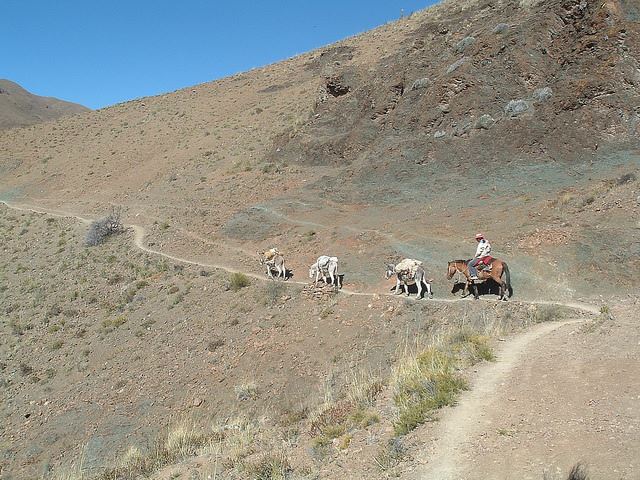


Spanning six countries and 273 distinct sites, the Qhapaq Ñan’s nomination as a UNESCO World Heritage Site was a global first. We unpick the backstory.
Not all UNESCO World Heritage Sites are created equal. Honoring and protecting a single cathedral or castle in a developed country with an established infrastructure is a relatively facile process, but doing the same for a road network which in its heyday spread across the length and breadth of the Andes is an entirely different prospect.
El Caminante awakens the sleeping giant
Section Type: imageOnLeftParagraphToRight
Were it not for the exploits of Peruvian author and adventurer Ricardo ‘El Caminante’ Espinosa, the Qhapaq Ñan may well have been forgotten by history. As recently as the 1990s the Qhapaq Ñan was – in the words of Espinosa – “just another legend, or in any event, a reality that time had snatched from us forever...which had lain hidden for centuries precisely because of its gigantic size.”
Ricardo 'El Caminante' Espinosa enjoys a rare breather alongside the Qhapaq Ñan.

This all changed with Espinosa’s well-publicized mission to walk and document the Inca road system. Between 1995 and 2002 he walked over 6,000 miles (much of it alone) and published two highly successful books (in Peru, at least) about his experiences. Through his vivid, relatable writing Espinosa had achieved what generations of archaeologists before him had failed to do: ignite public interest in the Qhapaq Ñan.
What began as a personal project soon gathered a momentum that transcended race, religion and borders…
Government steps in
Section Type: imageOnLeftParagraphToRight
In 2001 the Peruvian government first tabled the idea of applying for World Heritage status for the Qhapaq Ñan . A year later the other countries were brought on board, namely Argentina, Bolivia, Chile, Colombia and Ecuador. From the outset, all stakeholders’ saw their shared Inca heritage as “an exceptional opportunity for the integration and sharing of cultural values and the promotion of regional development among these six countries.”
The Qhapaq Ñan traverses some of the world's most pristine - and barren - landscapes.

In 2003 the six nations unanimously requested that the World Heritage Centre take charge of the coordination of the project due to its unique and pioneering nature. Unlike the establishment of the Qhapaq Nhan itself, this modern-day project would have to follow democratic processes and the players wisely chose to elect an impartial referee…
The big day finally arrives
Section Type: imageOnLeftParagraphToRight
When, in June 2014, the Qhapaq Ñan was finally confirmed as a UNESCO World Heritage Site, the New York Times described it as “a 12-year cooperative effort that is its own delicate feat of engineering” before going on to marvel at how “the six long-squabbling countries that are home to the Incan road have banded together.”
A particularly impressive piece of engineering in Jujuy, Argentina.

Naturally, it wasn’t perfect (there were rumblings that the indigenous communities themselves weren’t involved enough, especially in the early stages) but there is also very little doubt that the Qhapaq Ñan’s convocation is anything but a good thing. As Machu Picchu and the Galapagos Islands prove, placement on the heritage list clearly helps promote sites as important travel destinations.
Not to mention the fact that World Heritage status will help to protect the road network from its biggest threats, namely “encroachment from farms, particularly tractor plowing, as well as communication towers and transmission lines, urban development and mining.”
Why SA Expeditions got involved
Section Type: standardWidthImageS
Part of it is personal: our founder, Nick Stanziano, has a deep connection to the Andean region of Peru and he wants to enhance this connection by walking the Qhapaq Ñan. But it’s also bigger than that: One important aspect of our company’s activities is building high quality, inclusive, community based trekking tourism along Inca roads, as we have done in Choquechaca. "We believe that the future of luxury travel will be a blend of comfort, exclusivity and impact," says Nick, "And there's nowhere that these three variables engage more perfectly with one another than on the Qhapaq Ñan.”
Many sections, like this one in Argentina, are still in use today.

As Ricardo Espinosa said, “unlike normal archaeological sites that can be seriously damaged by tourists, roads decline and die when they are not used. Therefore using them responsibly and sensibly will preserve them for future generations. Walking brings us closer to the makers of the road. The way we walk this road will affect our future identity and it should be worthy of the original architects.”
Section Type: backgroundOnly
Further reading
The official UNESCO page about the Qhapaq Ñan contains loads of info, supporting doucments and an excellent photo gallery.
This fabulous essay written by Ricardo Espinosa in 2004 provided much of the backbone of this blog post and is a fascinating read in its own right.
This magnanimous article from the New York Times came out in 2014 – just before UNESCO World Heritage status was confirmed.
All images used in this blog were supplied by the various national authorities of Proyecto Qhapaq Ñan.


Copyright © 2025 SA Luxury Expeditions LLC, All rights reserved | 95 Third Street, 2nd floor, San Francisco, CA, 94103 | 415-549-8049
California Registered Seller of Travel - CST 2115890-50. Registration as a seller of travel does not constitute approval by the state of California.










